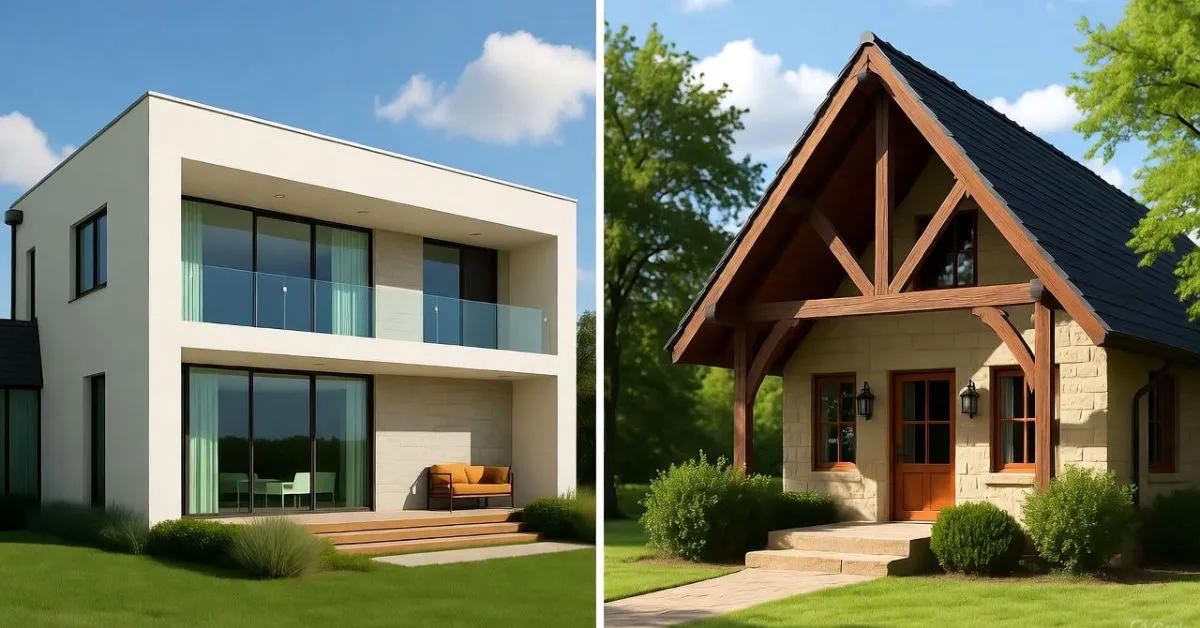Property
Houses in South Africa: Styles and Trends in 2025

Have you ever wondered why houses in South Africa look so different depending on where you are? From the colorful patterns on Ndebele homes to the elegant gables of Cape Dutch estates, these names tell stories of history, culture, and everyday life. Whether you’re curious about your roots or thinking about buying a place, let’s walk through what makes South African houses unique.
Key Takeaways
- Names of houses in South Africa reflect a blend of indigenous, colonial, and modern influences, with styles like Cape Dutch symbolizing heritage.
- Traditional ethnic homes, such as Zulu kraals, prioritize community and functionality, adapting to 2025 sustainability trends.
- Urbanization drives demand for affordable, eco-friendly adaptations, amid a 2.3 million housing shortage.
- Interest rates at 10.50% in October 2025 boost accessibility, with semigration favoring coastal Tuscan or contemporary designs.
- Knowing regional variations helps address pain points like maintenance costs and cultural preservation.
Traditional House Names and Styles
South Africa’s traditional houses aren’t just buildings—they’re tied to the land and the people who live there. Think about how a home can show family bonds or protect against the weather. These styles have evolved, but their core ideas stay strong.
Ethnic Variations by Group
Different groups have their own ways of building. Zulu kraals are enclosures with beehive-shaped huts, made for family gatherings and livestock. Xhosa homes often sit on ridges, with round walls and thatched roofs for better airflow. Ndebele homesteads stand out with bold, painted designs that carry family stories.
Picture a family in Limpopo keeping their Ndebele home’s patterns alive. These aren’t random—they symbolize heritage, passed down through generations. But with 69.3% of people now living in cities, these styles are fading in rural areas. That’s a shame, since they offer lessons in simple, effective design.
Cultural Symbolism
Names ofhouses in South Africa like rondavel come from the round shape, which stands for unity—no sharp corners to divide people. In Ndebele culture, the colors and shapes on walls act like family badges, sharing history without words. This ties into how homes foster community, something modern designs sometimes miss.
If you’re dealing with space issues in a small yard, consider a rondavel’s layout. It maximizes room without waste, perfect for tight urban spots. Yet, challenges like weather damage push people to update them.
Regional Differences
In the Eastern Cape, houses in South Africa blend Xhosa traditions with local materials like mud and grass. Gauteng sees more mixed styles, where old township houses get modern tweaks. Historic names here often nod to family legacies, like “Siyabonga House” meaning thanks.
Compare a rural mud hut to an urban adaptation: the first uses free local stuff but needs frequent fixes, while the second adds bricks for durability. This shift helps with the urban push, but it can dilute cultural ties.
Colonial and Historic House Names
Colonial times brought new ideas from Europe, mixing with local ways. These houses often have proper names, like estates that became landmarks. They show a shift to more structured living, but with South African twists.
Cape Dutch and Georgian Influences
Cape Dutch homes feature gabled fronts and white walls, named after Dutch settlers. Groot Constantia, from the 1600s, is a prime example—it’s not just a house but a wine farm with history. Georgian styles add symmetry, seen in older Cape Town spots.
These attract tourists, with over a million visiting heritage sites yearly. But owning one means dealing with upkeep. Imagine restoring gables: it keeps the charm but costs time.
Victorian and Art Deco Examples
Victorian houses have bay windows and ornate details, common in mining towns. Art Deco brings bold lines, from the 1930s era. Brutalism, with its concrete blocks, popped up post-war for quick builds.
Take Koopmans-de Wet houses in South Africa in Cape Town—now a museum, it shows how these styles adapted to local heat with verandas. They’re sturdy, but energy bills can sting without updates.
Modern and Emerging House Names
Today’s houses mix old and new, driven by needs like work-from-home setups. With house prices growing at 3.7% this year, people seek smart choices. Names now include “eco-villa” or “smart rondavel,” showing the blend.
Contemporary Adaptations
Tuscan villas, with tiled roofs and arches, suit sunny climates. They’re popular in estates for security. Contemporary designs add open plans, like in Gauteng’s mixed-use spots where homes sit above shops.
An example: a Gauteng estate with Tuscan touches and solar panels. This fits the trend toward live-work-play areas, making life easier amid traffic.
Sustainable Trends in 2025
With load-shedding still an issue, green features are key. Think solar-integrated rondavels or homes with rainwater tanks. The market values these, as rates stabilize at 10.50%.
Compare traditional thatch to modern solar setups: thatch cools naturally but rots, while solar cuts bills long-term. In 2025, trends like semigration to coasts boost demand for these.
Costs, Challenges, and Buying Tips
Buying a house here means navigating prices and rules. Average costs hit R1.5 million, but vary by area. With a 2.3 million unit shortage, it’s tough for many.
Affordability Insights
National growth is 3.7%, but real terms lag inflation. For 60% of Black households, that’s a barrier. The market’s worth $19.89 billion in residential, set to grow.
If rates drop to 10.25%, loans get easier. Tip: Start with pre-approval to know your budget.
Apartheid Legacies and Reforms
Townships from apartheid have basic structures, with ongoing ownership fights. 2024 rulings helped inheritance, but disputes linger. Upgrades in Soweto mix old rondavel ideas with new bricks.
This affects names—many reclaim family titles post-reform. It’s about more than walls; it’s identity.
Comparisons with Alternatives
Free-standing homes offer privacy but higher costs, versus clusters for shared security. Villas suit families, duplexes for rentals. Condos in cities cut maintenance, ideal for first-timers.
With approvals down 3% in early 2025, supply tightens. Choose based on lifestyle: estate for safety, township upgrade for affordability.
Final Takeaway and Call-to-Action
Names of houses in South Africa embody resilience and diversity—embrace them by exploring heritage sites or investing in sustainable adaptations. Visit Property24 or consult SAHRA for your next step in discovering or owning a piece of this architectural legacy.
FAQs
What are traditional houses in South Africa called?
Traditional houses in South Africa include rondavels, which are round huts with mud walls and conical thatched roofs, common among Xhosa and Zulu groups for their natural cooling and family-focused design. Kraals refer to fenced enclosures in Zulu culture, promoting communal living with multiple huts. Ndebele homesteads feature vibrant painted walls symbolizing family heritage and stories. These vary by region, like ridge-top Xhosa homes in the Eastern Cape for wind resistance. As urbanization rises to 69.3%, many adapt these for city life, blending tradition with modern materials to address weather vulnerabilities and space limits.
What is a rondavel house?
A rondavel is a circular African hut built with mud or stone walls and a conical thatched roof, designed for rural South Africa. It stays cool in heat and represents unity with its rounded shape, avoiding corners that could divide families. Often part of kraals, they’re functional for gatherings. In 2025, modern versions add solar panels or brick for durability against climate change. They’re affordable to build but need upkeep; costs start low using local materials. This style suits small families facing urban squeeze, offering lessons in simple, eco-friendly living amid a 2.3 million housing gap.
What types of houses are common in South Africa?
Common types span traditional rondavels and kraals to colonial Cape Dutch with gabled roofs, and modern Tuscan villas or clusters. Sectional titles like condos rise with urbanization at 69.3%, providing shared costs. Estates offer security, while townships feature basic upgraded homes. In 2025, sustainable hybrids like eco-rondavels gain traction due to load-shedding. Prices average R1.5M, with growth at 3.7%. Buyers favor coastal semigration for Tuscan styles. Alternatives include free-standing for privacy or duplexes for income, addressing pain points like affordability in a market worth $19.89B residentially.
Why are Bo-Kaap houses colorful?
Bo-Kaap houses in Cape Town got their bright colors after emancipation in the 1800s, when formerly enslaved Cape Malays painted them to celebrate freedom and express identity. This created a vibrant neighborhood landmark, blending Islamic and colonial architecture. Colors like pink, green, and yellow symbolize joy and community. Today, it’s a heritage site drawing tourists, but residents face gentrification pressures. Preservation rules protect the look, tying into broader cultural symbolism in South African homes. In 2025, similar trends inspire modern painted adaptations in townships, adding personality amid urban growth.
What is the average house price in South Africa?
Average house prices in South Africa stand at R1.5M in 2025, with national growth at 3.7% year-on-year, varying by region—cheaper in Gauteng under R1M, pricier in Cape Town. Amid rate cuts to 10.50% in October, affordability improves for first-timers. Inflation outpaces real growth at 2.2% in some data, hitting lower-income groups hard. Coastal areas see semigration boosts, while estates add premiums for security. With a 2.3M shortage, supply lags demand. Tips: Shop pre-approvals and consider sectional titles to lower entry costs in a market projected to grow residentially to over $19B.
How has apartheid affected house names in South Africa?
Apartheid enforced segregated townships with basic, unnamed structures, denying ownership and cultural expression to non-whites. Post-1994 reforms renamed areas and upgraded homes, but legacies include disputes over inheritance, with 2024 rulings aiding families. Many reclaim names tied to heritage, like family compounds. Urban shortages of 2.3M units stem from this, pushing informal settlements. In 2025, trends focus on inclusive estates blending styles. Pain points: 60% of Black households struggle with costs at R1.5M averages. Reforms promote equity, but slow progress highlights ongoing challenges in a 69.3% urban nation.
